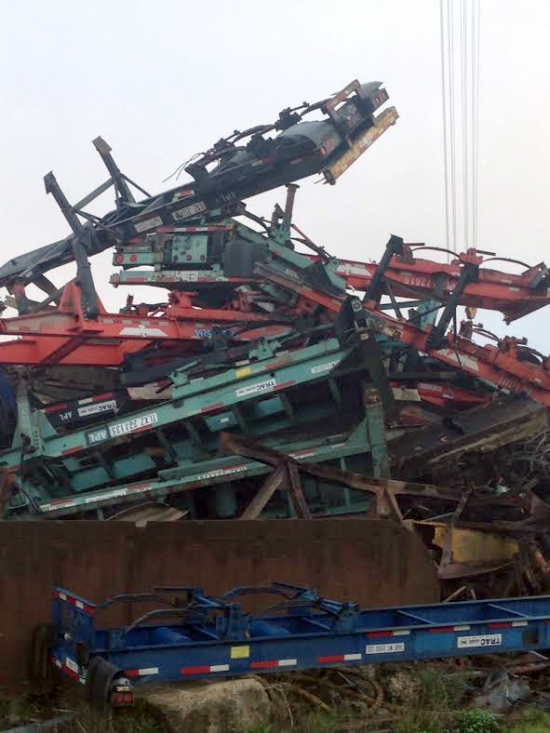The ILWU is not responsible for the ongoing congestion crisis at West Coast ports
SAN FRANCISCO, CA – Over the past week, the Pacific Maritime Association (PMA), which represents over 70 multinational ocean carriers and maritime companies in contract negotiations with the International Longshore and Warehouse Union (ILWU), issued news releases blaming labor for the congestion problem that is plaguing major West Coast ports. PMA’s press releases accused the ILWU of threatening “to stem the flow of cargo during the final holiday season push.” Obscuring months of data regarding the non-labor related causes of the current crisis-level congestion problem, PMA’s Texas-based public relations firm announced that the ILWU was the cause bringing “the port complex to the brink of gridlock.” The public relations firm also propagandized about the ILWU, its leadership, and false claims of safety issues.
The ILWU is not responsible for the ongoing congestion crisis at West Coast ports. The documented causes of congestion at the ports include:
- Chassis shortage and dislocation;
- Rail service delays, including a shortage of rail cars nationwide;
- The exodus of truck drivers who cannot make a living wage;
- Long truck turn times;
- Record retail import volumes (increases of 5.3 percent over 2013);
- Larger vessels discharging massive amounts of cargo;
- Container terminals pushed to storage capacities; and
- The peak shipping season (i.e., the August through October pre-holiday surge).
Adding to this, on September 23, 2014, the Port of Los Angeles experienced its largest fire in decades, forcing the evacuation of 850 workers and resulting in the temporary closing of three of six cargo terminals, causing delays in the movement of cargo that reverberated down the supply chain.
The congestion problem is so acute that the Port of Long Beach recently convened “a high-level Congestion Relief Team to meet daily, seek solutions, and solicit feedback” (Port of Long Beach News Release, October 7, 2014). For months, the Federal Maritime Commission has been hosting public forums on U.S. port congestion to explore possible solutions. Dr. Noel Hacegaba, Chief Commercial Officer of the Port of Long Beach, recently explained that the shortage of chassis is the root of the congestion problem (Long Beach Post, “The Port of Long Beach Asserts Congestion Crisis is a Strategic Issue,” October 28, 2014). Lee Peterson, a spokesperson for the Port of Los Angeles, stated, “We don’t see the longshore contract negotiations as a factor in the congestion. The cause is due to the chassis situation and the high volume of cargo this peak season.” (Long Beach Post, October 28, 2014).
It is well known that “the chassis situation” was caused by the shippers themselves when they changed their chassis operations model early this year. “The chassis problem … is a direct result of shipping lines selling their chassis to equipment-leasing companies. This has created an environment in which chassis that are controlled by one pool operator are not being shared with other pool operators. This results in split-moves, where a trucker must drop a container off at one terminal and the chassis at another. It has also resulted in chassis hoarding by some terminals to ensure they have enough equipment for the next vessel call. Also, chassis are experiencing longer dwell times at distribution warehouses and off-dock rail yards than in the past, in effect reducing the number of chassis that are available to haul containers on any given day.” (Journal of Commerce, “Chassis Fingered as Biggest of Many Problems at LA-Long Beach,” September 27, 2014).
There is also a major shortage of longshore workers and marine clerks. “The extra demand on longshore labor has emerged as a real problem in Los Angeles-Long Beach. Terminals throughout the summer have been forced to increase their use of part-time longshoremen, known as casuals, who generally are not as productive as their veteran counterparts. On some nights, terminals exhaust their entire roster of registered and casual labor, and still can’t fill of the labor slots needed for that work shift.” (JOC quoting PierPass President and CEO Bruce Wargo, “Chassis Fingered as Biggest of Many Problems at LA-Long Beach,” September 27, 2014). Despite ILWU demands, PMA repeatedly refused to increase the size of the full-time workforce prior to the start of negotiations.
“The numerous, non-labor related causes of the congestion problem up and down the West Coast are well documented,” said ILWU spokesperson Craig Merrilees. “During negotiations last week, the Union addressed PMA directly to express concerns about its deceitful media tactics and the corrosive impact of such tactics on collective bargaining. It’s particularly inflammatory for workers to be told that they’re using safety as a gimmick.”
West Coast longshore work is extremely hazardous, with higher fatality rates than the work of firefighters or police officers, according to U.S Department of Labor figures. The biggest factor causing accidents on the docks is the employers’ constant demand for increased production. In the face of this demand and the Union’s concern for the safety of its members, the ILWU has negotiated one of the best safety codes in the industry. The ILWU is committed to safety and will adhere to the ILWU-PMA Pacific Coast Marine Safety Code.
“The men and women of the ILWU will not make up for the current supply chain failures at the expense of life and limb,” said Merrilees.
Negotiations continued Monday after the parties worked through the weekend.
# # #
— ILWU news release

